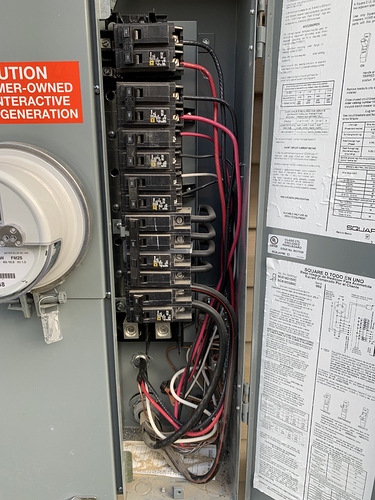Based on my main panel, how many CTs would I need to purchase to measure whole home consumption as well as solar production? I’m not sure if I’d have enough room to fit CTs on the mains, so I’d be open to just put the CTs on the sub-panel, A/C, etc. and combine for whole-home consumption.
I’m in the US with a split-phase setup (mains1 and mains2) combined to provide 240v at 60h. So, have two CTs for my two mains connections which provide you both energy import from the grid along with export from solar if you desire. I also have two CTs covering my two solar connections in my panel; I believe you can use one CT for this and select the double option it as well. So, with four (or three) CTs, you could monitor your consumption, import and export. If you want additional granular details, you can as well add CTs to any high load items like AC, Range, Furnace, or well/pool pumps.
Looking at your setup, it appears to be split phase, but you seem to have two connections to your solar at the top of the panel . You would need one CT to cover it (doubling) or two to cover both connections. Also, you could buy CTs for the range, dryer, and AC if you wanted to pick this up as well. Not sure what the four wires on the single disconnect near the bottom are…
It comes down to what you want to monitor and how much data you want to collect. Again, you are limited to the total number of CT that the IoTaWatt can support (14) and budget. This also changes based on your setup of split-phase or three-phase power setup. May need more info to give you the necessary numbers. You will also need to have a box to place the IoTaWatt along with a circuit for powering the unit and as a voltage reference.
So the 4 wires on the single disconnect is the service disconnect, which seems to be different than what a lot of other people have. I did stumble across a similar post with a very similar setup recently. It was suggested to pull the meter and connect the CTs. But I think I’d rather try to connect the CTs to the 4 wires coming in from the meter (if they’ll fit) or even better just connect CTs to the sub panel, A/C, range, etc. so I can get the whole picture. So if I’m understanding this correctly I’d need (4) 50A CTs for the solar, A/C, Range, Dryer, and (2) 100A CTs for the sub-panel? Or would I only need (1) 100A CT for the sub-panel and double it?
As always, I recommend to folks that they have an electrician or other qualified person install the CTs. That person would also know how it’s put together.
That said, there is a diagram of the internal wiring right there on the cover. According to that diagram, you are correct that the four poled breaker in between positions 6 and 7 is the main service disconnect. The total breaker is rated 200A per leg, so each individual breaker is nominally 100A, which is supported by the size of the cables that connect them to the main bus in the meter side.
To measure the mains would require four 100A CTs and four inputs to the IoTaWatt. The 100A CTs are about 1.25" wide and the distance between wire centers should be nominally 1". So there is 2" - one wire diameter available for the CT if they are staggered, which should be adequate. That said, it will be a tight fit and you have no way to de-energize those conductors.
Your plan B may be a better approach, not only for ease of installation, but because it has the added benefit of breaking out your AC, Dryer and Range. The Range and Dryer are three wire (have neutral) so they would require two 50A each, and the AC looks to be two wire (no neutral) so that can do with one 50A. The sub-panel would require two 100A.
@quella is right that the solar can be done with one 50A CT.
So the total is:
- four 100A and one 50A to go the mains route
- two 100A and six 50A to go with the divide and conquer
- six 100A and six 50A to do the whole shebang
Given that most of your load detail is aggregated in the sub-panel, the divide-and-conquer approach should give you good results. Note that with this equipment, the solar feeds in before the mains, so the outputs to measure use and export will be a little different than a typical setup where the solar comes into the load-center on the house side of the mains.
Perfect, that’s exactly what I was wondering. Thanks so much!
I need 2 cts to monitor my electric dryer right cause of it using 120v aswell as 240v
Either that or pass both both conductors through one CT in opposite directions and use a single voltage reference.

